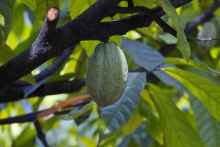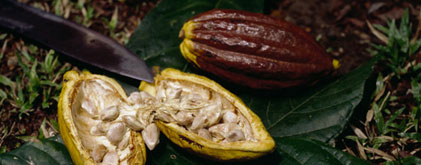Cacao beans - how is chocolate made?
From cacao pods to cocoa and the chocolate bars we love...

All chocolate starts its life as cacao-beans growing inside a pod on a Theobroma cacao tree.
The beans are harvested and scooped out. They are then usually fermented (not always) and dried in the sun (not always) at the plantation. Cacao beans are then sent to chocolate factories to be processed and prepared for the manufacture of various chocolate products, - eating chocolate, cocoa powder etc.
With the beans still in their husks and dusty with the remains of the pulp, the first thing to do is to wash them and discard any of the undesirable muck and bits. The cleaned and graded beans are then passed on for roasting.

Roasting
This is a very important and tricky part of the chocolate-making process. It develops the flavour and aroma, and enriches the colour. It also dries the husk surrounding the cacao bean, so the husk separates away from the "nib" inside more easily, and dries the nib ready for grinding. Getting it just right is important, as this will greatly affect the final flavour.
Also, different types of cacao beans need different roasting temperatures. The milder beans are roasted at a lower temperature than the stronger cacao bean varieties.
Winnowing
This is the separating of the husks from the nibs. The husks are used for garden mulch, or for making low-quality soft "shell butter".
Blending
The various types of beans are generally divided into either strong or mild varieties.
Strong varieties
Accra
St. Lucia
Para
Trinidad
Grenada
Surinam
Cuba
Dominica
Mild varieties
Caracus
Mauritius
Sri Lanka
Arriba
Madras
Jamaica
Sychelles
So, chocolate made from just Accra beans would be very strong, but by mixing different proportions of the strong cacao beans with the mild varieties, a much better finished chocolate flavour is made; hence the quality of all chocolate is directly related to this vitally important blending of the cacao beans.
It takes considerable skill and knowledge, developed over many years, to know how to blend the cacao beans in the appropriate variations to produce the optimum chocolate experience. These recipes are highly secret and jealously guarded by the blenders and manufacturers.
Once the blending is finished, the nibs are sent for grinding.
Grinding
Under the grinders, the nibs are ground till the heat of the process turns them into a warm paste. With a particle size of 0.001 inch, the cocoa mass or "liquor" flows into containers from the grinding machine.
It is at this stage that the treatment of the "liquor" depends on what the "liquor" is going to be used for. If it is to be cocoa powder, a large proportion of the cocoa butter is extracted, and the residue is ground again to make an even finer powder.
Some cocoa is "dutched", which makes the powder easier to mix with water. This also improves the colour and lightens the flavour. Also, lecithin can be added to improve the mixing abilities of the powder.
Now to return to how eating-chocolate is made, as so far, this is just the beginning!
Mixing
The roasted blended ground nibs destined to be eating-chocolate are treated very differently from those that go on to be used in cocoa powder.
They continue their journey by being pulverised with sugar and enriched with cocoa butter. Some mass producers of eating chocolate add lecithin, a vegetable fat, so the more expensive cocoa butter is sold off for profit separately.
The mixture then goes on to the "melangeur" - a round machine with a horizontal rotating base, which runs on heavy rollers. The nibs now look like well-kneaded dough. If they are going to be made into milk chocolate then powdered milk or evaporated sweetened milk is added.
Refining
This paste is then ground further between five rollers, each spinning faster than the last. The paste comes out of each successive roller thinner and thinner.
As far as some producers are concerned this is the end of the process. For high quality chocolate though, further processing is required.
Conching
Invented by Rodolfe Lindt in 1880 to create fine chocolate, the conching machine (conch meaning "shell" which is what it looks like) gently agitates the liquid chocolate for up to a week. Some manufacturers follow this process only for a few hours, but the longer the process is done, the more velvety and smooth and less bitter will the chocolate be. Some manufacturers add cocoa butter to make it smoother still.
It is during conching that any flavours used are added, such as vanilla, cloves, cinnamon, lavender and many other flavours, as our chocolate taste gets ever more sophisticated, but that other Mexico find, vanilla, is always added. This is just as the Aztecs did hundreds of years ago.
Pure vanilla extract is used for the best quality chocolate, while cheaper chocolate varieties use vanillin, a synthetic substitute.
Once conching is complete, the chocolate is fed into tempering kettles.
Tempering
This is where the chocolate is stirred and carefully cooled, though still warm enough to be kept as a liquid.
Keeping it liquid is a very tricky process as there are lots of different fats, all with different setting and melting points. For example, if some of the fats are cooled too quickly they separate from the mass and create a white "bloom" on the finished chocolate.
Tempering results in the chocolate being smoother, as it distributes the various fats, improving the quality of the finished chocolate.
After tempering, the chocolate is finally made into the vast variety of products we buy.
Chocolate bars are put through moulding machines, while chocolate used in the coating of chocolates is pumped into enrobing machines, to be poured carefully over the huge range of centres we love so much. Other chocolate is poured into moulds to make Easter, Christmas and other gifts we buy throughout the year.
The Cacao Tree
View video footage of the chocolate making process. This is a wonderful site and gives lots of lovely information on the cacao tree, harvesting cacao pods and producing chocolate.
Return from learning about cacao beans to the best chocolate recipes online home page.
Share this page:
What's This? Enjoy this page? Please pay it forward. Here's how...Would you prefer to share this page with others by linking to it? Click on the HTML link code below. Copy and paste it, adding a note of your own, into your blog, a Web page, forums, a blog comment, your Facebook account, or anywhere that someone would find this page valuable.<a href="https://www.best-chocolate-recipes-online.com/Cacao-beans.html">Cacao beans, how is chocolate made, chocolate facts, cocoa butter.</a>
